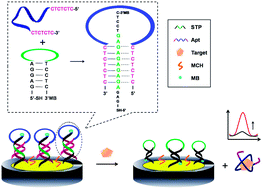A signal on aptamer-based electrochemical sensing platform using a triple-helix molecular switch†
Abstract
An aptamer is a useful molecular recognition tool for the design of various biosensors owing to their diversified structures, good biocompatibility, high affinity, and specificity for binding a wide range of non-nucleic acid targets, from small molecules to whole cells. Herein, we developed a signal on aptamer-based electrochemical sensing platform by taking advantage of a triple-helix molecular switch. In this sensing platform, two tailored DNA probes were involved for constructing a triple-helix molecular switch. One was a label-free target specific aptamer sequence (Apt) flanked by two arm segments, called as a recognition probe. The other, serving as a signal transduction probe (STP), was designed as a hairpin-shaped structure and labeled with methylene blue (MB) and a sulfhydryl group at the 3′ and 5′-end, respectively. The target specific Apt contained triple-helix DNA (Apt–THDNA) was formed by binding two arm segments of the Apt with the loop sequence of STP, and then self-assembled onto the gold electrode via Au–S bonding. Due to the “open” configuration of STP in the Apt–THDNA, the methylene blue modified on the STP was far away from the electrode. It was eT OFF state. Formation of an aptamer/target complex disassembled the Apt–THDNA and retained the STP section on the gold electrode. Subsequently, the retained STP on the gold electrode could form a hairpin-shaped configuration, mediating the methylene blue approach onto the gold electrode surface to generate redox current. It was eT on state. The developed facile signal on aptamer-based electrochemical sensing platform using a triple-helix molecular switch showed a linear response to the concentration of human α-thrombin (Tmb) ranging from 10 to 100 nM. The detection limit of Tmb was determined to be 4.5 nM. Furthermore, the universality of the sensing platform was investigated by virtue of altering the Tmb aptamer sequence to the adenosine triphosphate (ATP) aptamer sequence. A linear response to the concentration of ATP ranging from 100 to 500 nM and a 60 nM detection limit were obtained.


 Please wait while we load your content...
Please wait while we load your content...